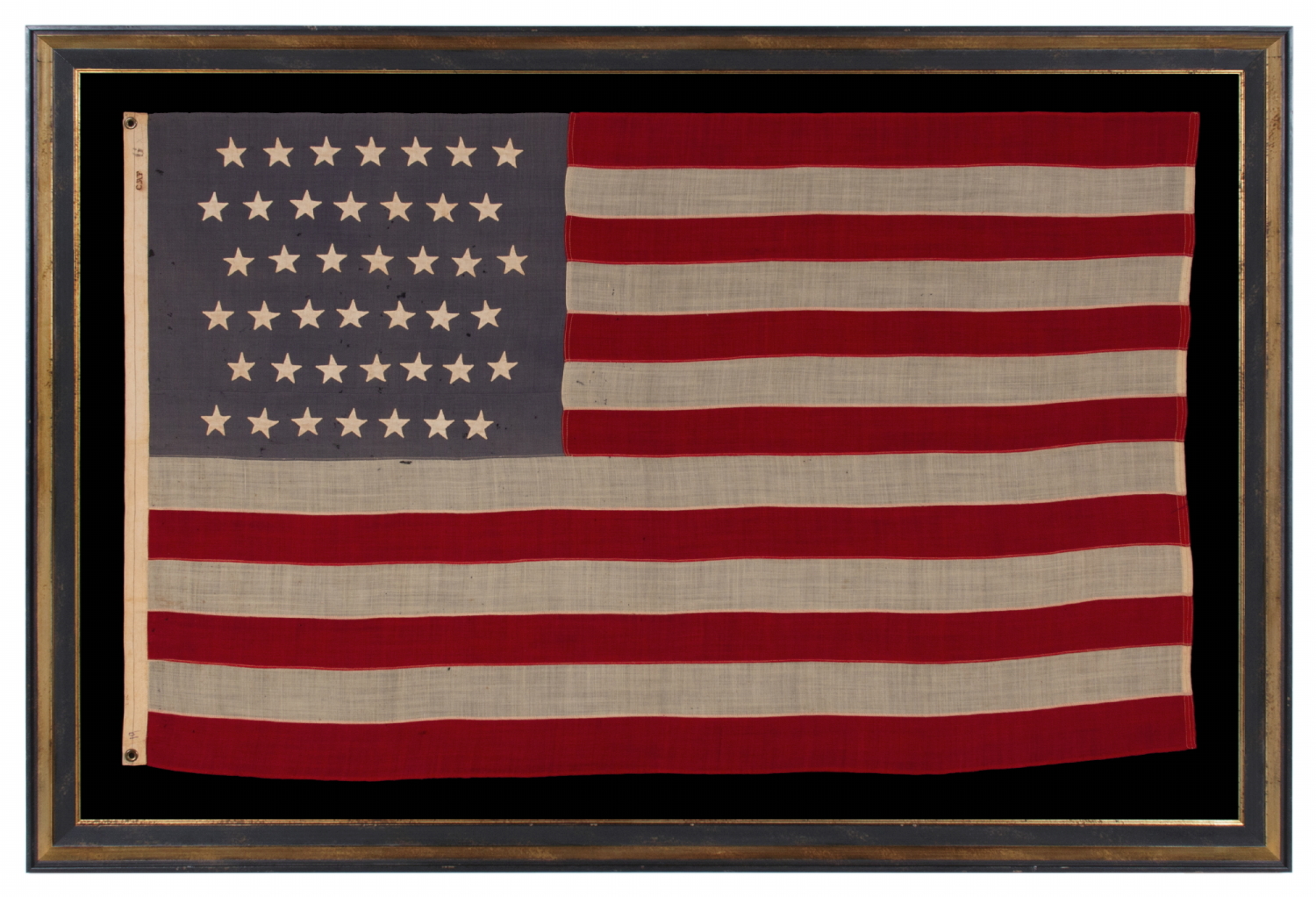
| |
42 HAND-SEWN STARS ON AN ANTIQUE AMERICAN FLAG WITH A DUSTY BLUE CANTON; AN UNOFFICIAL STAR COUNT THAT REFLECTS THE ADDITION OF WASHINGTON STATE, MONTANA, AND THE DAKOTAS, circa 1889-1890 |
|
| Available: |
Sold |
| Frame Size (H x L): |
Approx. 57" x 83" |
| Flag Size (H x L): |
45" x 71" |
|
| Description....: |
|
42 star American national flag, with hand-sewn stars and attractive coloration. The 42 star flag is interesting from a historical perspective, both because 42 was never an official star count, and because 42 star flags were only produced for about 8 months. The flag represents the addition of the Dakotas, Montana, and Washington State, between November 2nd and November 11th, 1889. The 42nd state was officially Washington, but the four states gained their statehood only nine days apart, and flag makers added 4 stars, accordingly, to the count of 38 that was official at the time.
After the Third Flag Act, passed by Congress in 1818, star counts became official each year on the 4th of July. At this time, a new star was added for every state that had entered the Union over the preceding “flag year” (July 4th – July 3rd). Flag makers, however, did not wait for Independence Day and “official” star counts. In fact, on many occasions, particularly during the last quarter of the 19th century, the number of territories becoming states was merely speculated and stars were added in advance, even before the respective territories became states. Flag-making was a competitive industry, and no one wanted to be making 38 star flags, for example, when their competitors were making 42 star flags, especially after there were actually 42 states. It was for these reasons that 42 star flags were produced by numerous makers, primarily between November of 1889 and July of 1890.
On July 3rd, 1890, Idaho gained statehood, taking the star count to 43 just one day before 42 would have become the official number. This fact makes 42 star flags an interesting part of our heritage and a classic display of American capitalism.
The stars of the flag are arranged in staggered rows, each of which contains 7 stars. These are made of cotton, hand-sewn, and double-appliquéd (applied to both sides). The canton and stripes of the flag are made of wool bunting that has been pieced with treadle stitching. There is a twill cotton binding along the hoist end with 2 brass grommets, on which the numeral "6" is stenciled, in black, on the obverse, near the top of the hoist, to notate the length in feet. The letter "X" is penciled after this and the number “19” is inscribed near the bottom in blue pencil. Just below the numeral “6,” the initials “C.A.F.” are inscribed with a dip pen. These would represent the initials of a former owner and it was typical to mark flags in this manner during the 19th and early 20th centuries.
Note how the coloration of the canton has faded to a dusty blue-grey. When this trait is found in this particular weave of blue bunting, it is most often in flags that date between 1885 and 1895, and more often in the second half of that ten-year date bracket. After 1895, either flag manufacturers caught on to the fugitive dye and ordered different wool, or the textile company that was producing it changed the dying process. In any event, flags that were made with this wool and have survived to the present have an interesting presentation that many collectors find attractive.
In the 19th century, flags with sewn construction (as opposed to printed) were typically eight feet long or larger. Because flags needed to be seen and recognized from a great distance, large size important to their function as signals. A length of six feet on the fly was considered small and production of flags smaller than this was extremely limited. Because the average 19th century sewn flag can be cumbersome to frame and display in an indoor setting, many collectors prefer printed parade flags, which were far smaller on average, and small-scale sewn flags, like this one.
Mounting: The flag was mounted and framed within our own conservation department, which is led by expert staff. We take great care in the mounting and preservation of flags and have framed thousands of examples.
The background is 155% cotton twill, black in color, that has been washed and treated to reduce excess dye. The mount was placed in a black-painted, hand-gilded and distressed Italian molding. The glazing is U.V. protective acrylic.
Condition: There is minor mothing in the striped field and modest mothing in the canton. There is very minor foxing and staining. Many of my clients prefer early flags to show their age. |
|
|
|
| Collector Level: |
Intermediate-Level Collectors and Special Gifts |
|
| Flag Type: |
Sewn flag |
|
| Star Count: |
42 |
|
| Earliest Date of Origin: |
1889 |
|
| Latest Date of Origin: |
1890 |
|
| State/Affiliation: |
Washington |
|
| War Association: |
1866-1890 Indian Wars |
|
| Price: |
SOLD |
|
| |
Views: 1294 |
|
|
|

